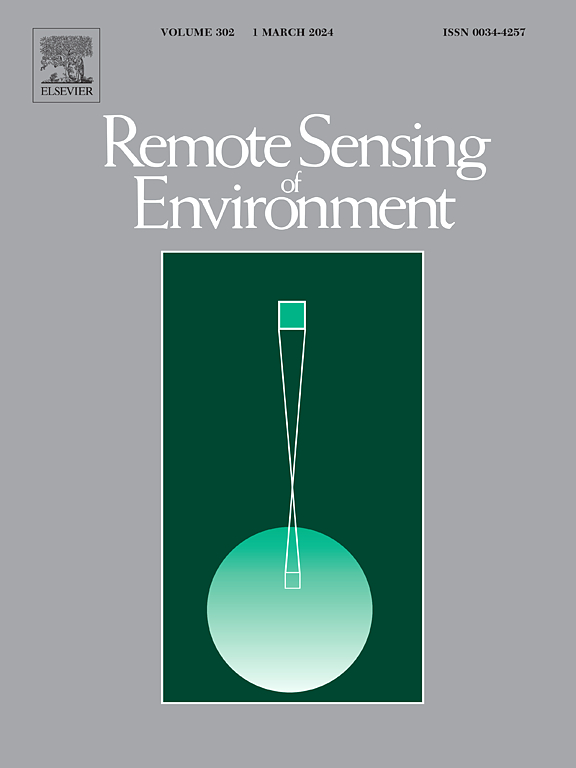A gradient-based nonlinear multi-pixel physical method for simultaneously separating component temperature and emissivity from nonisothermal mixed pixels with DART
IF 11.1
1区 地球科学
Q1 ENVIRONMENTAL SCIENCES
引用次数: 0
Abstract
Component temperature and emissivity are crucial for understanding plant physiology and urban thermal dynamics. However, existing thermal infrared unmixing methods face challenges in simultaneous retrieval and multi-component analysis. We propose Thermal Remote sensing Unmixing for Subpixel Temperature and emissivity with the Discrete Anisotropic Radiative Transfer model (TRUST-DART), a gradient-based multi-pixel physical method that simultaneously separates component temperature and emissivity from non-isothermal mixed pixels over urban areas. TRUST-DART utilizes the DART model and requires inputs including at-surface radiance imagery, downwelling sky irradiance, a 3D mock-up with component classification, and standard DART parameters (e.g., spatial resolution and skylight ratio). This method produces maps of component emissivity and temperature. The accuracy of TRUST-DART is evaluated using both vegetation and urban scenes, employing Advanced Spaceborne Thermal Emission and Reflection Radiometer (ASTER) images and DART-simulated pseudo-ASTER images. Results show a residual radiance error is approximately 0.05 W/(m2·sr). In absence of the co-registration and sensor noise errors, the median residual error of emissivity is approximately 0.02, and the median residual error of temperature is within 1 K. This novel approach significantly advances our ability to analyze thermal properties of urban areas, offering potential breakthroughs in urban environmental monitoring and planning. The source code of TRUST-DART is distributed together with DART (https://dart.omp.eu).
基于梯度的非等温混合像元的非线性多像元物理分离方法
组分温度和辐射率是了解植物生理和城市热动力学的关键。然而,现有的热红外解混方法在同时检索和多组分分析方面面临挑战。我们提出了基于离散各向异性辐射传输模型(TRUST-DART)的亚像元温度和发射率的热遥感解混,这是一种基于梯度的多像元物理方法,可以同时从城市地区的非等温混合像元中分离出组分温度和发射率。TRUST-DART利用DART模型,需要输入包括地面辐射图像、下沉天空辐射、带有组件分类的3D模型和标准DART参数(例如空间分辨率和天窗比例)。这种方法产生组件发射率和温度的图。利用先进星载热发射和反射辐射计(ASTER)图像和模拟的伪ASTER图像,利用植被和城市场景对TRUST-DART的精度进行了评估。结果表明,残余辐射误差约为0.05 W/(m2·sr)。在不存在共配准和传感器噪声误差的情况下,发射率的残差中值约为0.02,温度的残差中值在1 K以内。这种新方法大大提高了我们分析城市地区热特性的能力,为城市环境监测和规划提供了潜在的突破。TRUST-DART的源代码随DART一起发布(https://dart.omp.eu)。
本文章由计算机程序翻译,如有差异,请以英文原文为准。
求助全文
约1分钟内获得全文
求助全文
来源期刊

Remote Sensing of Environment
环境科学-成像科学与照相技术
CiteScore
25.10
自引率
8.90%
发文量
455
审稿时长
53 days
期刊介绍:
Remote Sensing of Environment (RSE) serves the Earth observation community by disseminating results on the theory, science, applications, and technology that contribute to advancing the field of remote sensing. With a thoroughly interdisciplinary approach, RSE encompasses terrestrial, oceanic, and atmospheric sensing.
The journal emphasizes biophysical and quantitative approaches to remote sensing at local to global scales, covering a diverse range of applications and techniques.
RSE serves as a vital platform for the exchange of knowledge and advancements in the dynamic field of remote sensing.
 求助内容:
求助内容: 应助结果提醒方式:
应助结果提醒方式:


